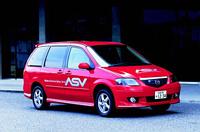Mazda Begins Public Road Trials of Advanced Safety Vehicle
Tokyo, Japan, Dec. 16, 2002 - (JCN Newswire) - Mazda Motor Corporation will begin public road trials of its advanced safety vehicle. Based on the Mazda MPV, the test vehicle obtained approval from the Land, Infrastructure and Transport Minister and is registered for use on public roads. Through these trials, Mazda will collect and analyze data for the development of future products. Testing will be conducted on public roads near Mazda's Hiroshima headquarters, as well as in the Tokyo metropolitan and Kansai areas. Mazda advanced safety vehicle (MPV test vehicle for public road use) The test vehicle is equipped with the following safety technologies: 1) Safety technologies to prevent accidents - Full speed range adaptive cruise control system with brake control - Advanced front-lighting system - Forward obstacle information/warning system (pedestrian warning) 2) Safety technologies to reduce injury in the case of an accident - Neck injury mitigation system for rear-end collision Mazda has been participating in the Transport Ministry's (now the Ministry of Land, Infrastructure and Transport) ASV project since 1991. During this time the automaker has developed a number of advanced safety technologies designed to prevent accidents as well as to reduce injury in the event of an accident. In 1995 Mazda developed its first test vehicle 'Mazda ASV', and in November 2000 exhibited 'Mazda ASV-2' at 'Smart Cruise 21 Demo 2000', a public demonstration hosted by the Transport and Construction Ministries. Developed from the viewpoint of 'pedestrian protection' and 'whiplash injury mitigation', the vehicle incorporated many safety features unique to Mazda with a focus on reducing injury to pedestrians and minimizing whiplash injury in frequently occurring rear-end collisions. In these ways Mazda continues to promote the development of advanced safety technologies. Outline of the safety technologies 1) Full speed range adaptive cruise control system with brake control: With this feature, the distance between two vehicles is maintained by adjusting the speed within the range set by the driver based on information from a laser radar. This enables control in all speed ranges, including high speed driving on motorways, and mid-low range daily driving, and even when stopping. This releases the driver from frequent speed adjustments helping to alleviate driver fatigue. 2) Advanced front-lighting system: This safety feature controls distribution of luminous intensity emitted from headlamps during the night according to driving conditions, road conditions, and steering angle. The distribution area has been enlarged to improve driver visibility and recognition of traffic signs and pedestrians. 3) Forward obstacle information/warning system (pedestrian warning): This safety feature judges the degree of danger based on the distance between the vehicle and an object in front measured by a laser radar, and the vehicle's speed/braking status. In accordance with the degree of danger, appropriate warning is given to the driver using visual and sound information to reduce the number of collisions with vehicles ahead and pedestrians who are in the vehicle's path. 4) Neck injury mitigation system for rear-end collision: With this system, the seatbelt restrains passengers in an appropriate posture just before a rear-end collision. It can predict a rear-end collision by detecting the distance from and the speed of a following vehicle using a laser radar mounted at the rear of the vehicle. When the system predicts a rear-end collision, the seatbelt is wound up by a motor to pull passengers back into the seatback. As a result, it reduces the distance between the passengers' head and headrest, minimizing the severity of whiplash injuries. About Mazda Motor Corporation Mazda Motor Corporation was established in 1920 and is one of Japan's leading automobile manufacturers. With its headquarters in Hiroshima, Mazda has two plants in Japan and manufacturing and assembly operations in sixteen other countries. Mazda cars and trucks are sold in more than one hundred and thirty countries. Ford Motor and Mazda agreed to collaborate in 1979, Ford Motor Company started investing in Mazda and increased its shareholding to 33.39% as of March 31, 1999. For further information, please visit the Mazda Motor Corporation home page at: www.mazda.com/flash.html <http://www.mazda.com/flash.html>



